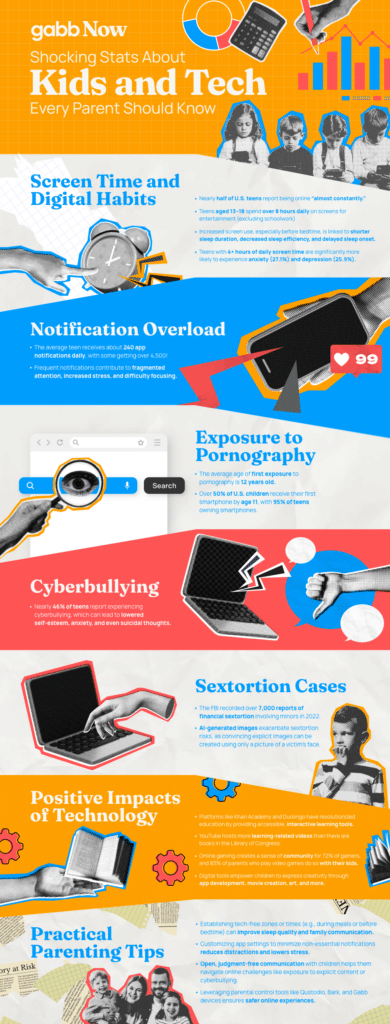From social media apps to online games and educational tools, our kids are growing up in a vastly different environment than most of us did. But just how much is technology shaping their lives?
Here are some surprising stats on how kids are engaging with technology that can inform how we, as parents, can guide them toward healthier digital habits.
Nearly Half of Teens Report Being Online “Almost Constantly”
If you’ve ever felt like your teen can’t put their phone down, you’re not imagining it. About 50% of U.S. teens say they’re online nearly all the time. This constant connectivity not only steals hours from the day, but it can also crowd out healthier activities like reading, exercise, or face-to-face interactions. Establishing tech-free zones—like during dinner or before bedtime—helps kids develop balanced habits and remember there’s life beyond the screen.

Teens with 4+ Hours of Screen Time Face Higher Anxiety and Depression
Research shows a direct link between excessive screen use and mental health challenges: teens spending four or more hours on screens daily are more likely to experience anxiety (27.1%) and depression (25.9%). While digital devices are a big part of modern life, it’s crucial to set realistic boundaries. Encourage kids to enjoy tech in moderation while prioritizing sleep, family time, and offline interests.

The Average Teen Receives 240 App Notifications a Day
Endless pings—from texts, social media, and game alerts—can spike stress levels and disrupt focus. It’s no wonder many teens struggle to complete homework or enjoy family time when their phones are buzzing nonstop. By customizing notification settings or using “Do Not Disturb” modes, teens can regain control over their attention and create a healthier digital environment.

The Average Age of First Porn Exposure Is 12
Kids are encountering explicit content at younger ages, sometimes unintentionally. While filters and parental controls help, open communication is the strongest line of defense. Let your child know they can come to you with questions, without shame or punishment. That dialogue can help them process what they see and steer clear of harmful content.

Nearly 46% of Teens Have Experienced Cyberbullying
Cyberbullying doesn’t end when the school bell rings—it follows kids onto social media and messaging apps, making it feel inescapable. Encourage your teen to recognize bullying, use block and report tools, and speak up when they feel attacked. Remind them that reaching out for help isn’t a sign of weakness; it’s a way to protect their emotional well-being.

Sextortion Cases Surpassed 7,000 Among Minors in One Year
The FBI reports more than 7,000 financial sextortion cases involving minors in just a single year, and emerging AI tools make it easier to generate fake images. Reassure your kids that they’re never alone, no matter what threats or demands come their way. Make sure they know to alert a trusted adult immediately—together, you can reach out to law enforcement or support services to keep them safe.

YouTube Holds More Educational Videos Than the Library of Congress Has Books
It’s not all doom and gloom—digital platforms can be a goldmine of knowledge. From learning a new language to exploring science experiments, kids have near-limitless opportunities to expand their skills. To keep them on track, guide them toward content that builds curiosity and understanding rather than veering into mindless scrolling.

72% of Gamers Find a Sense of Community Through Online Play
For many kids, gaming is social—not just solitary. Online games can help them maintain friendships or even bond with family members who live far away. By playing together or setting up virtual game nights, you can connect with your kids in a space they love.
If your child is ready for online play, set up parental controls and teach them to stay safe by setting clear rules about interactions with strangers, recognizing suspicious behavior, and knowing when to leave a game or ask for help.

Practical Ways to Encourage Digital Wellness
Small changes make a big difference. Turn off non-essential notifications, try “phone-free” meal times, and keep conversations about online life open and non-judgmental. Consider devices designed to prevent social media and limit unsafe content — preventing harm is better than repairing it. With a little guidance, kids can reap the benefits of technology while staying safe, balanced, and confident in the digital world.
Set Boundaries: Create tech-free moments or places to encourage real-life interaction.
Manage Notifications: Fewer pings mean more focus and less stress.
Talk Openly: Keep lines of communication judgment-free.
Role Model: Be an example of balanced digital habits yourself.
Use Parental Controls: Opt for tools built for kids, not adult tech with controls slapped on after-the-fact.

Remember: Technology isn’t going anywhere, so teaching our kids digital wellness is a crucial life skill that sets them up for success — online and off.










Success!
Your comment has been submitted for review! We will notify you when it has been approved and posted!
Thank you!